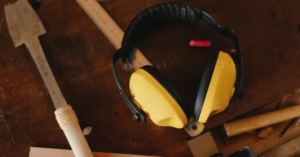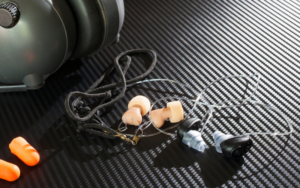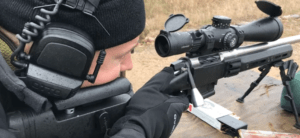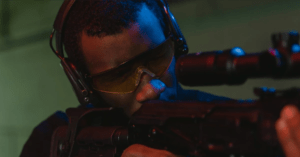Shooting Ear Protection – It’s Just Common Sense
 It’s a common sense thing to know, especially for anyone who loves shooting guns, that without hearing protection, a single gunshot can lead to permanent hearing loss. Shooting can be safe and fun when practiced with the proper precautions. Hearing protection is one of those precautions.
It’s a common sense thing to know, especially for anyone who loves shooting guns, that without hearing protection, a single gunshot can lead to permanent hearing loss. Shooting can be safe and fun when practiced with the proper precautions. Hearing protection is one of those precautions.
Life without being able to hear due to hearing loss from shooting weapons because you didn’t pro actively protect your hearing doesn’t have to happen and if it does it’s not the gun’s fault, but your own fault. Don’t let this happen to you.
3 Types of Hearing Protection
There are three types of hearing protection commonly used for shooting:
Ear muffs With Active Noise Cancelling Built In
If necessary, shooters can combine plugs and muffs to get more hearing protection than either offers alone.
How Hearing Loss Occurs
Hearing loss is triggered by exposure to loud noises. Both the intensity of the noise and the duration of the exposure dictate the amount of hearing loss While gunshots are quite short, they are incredibly loud — between 140 and 175 dB, depending on the caliber and type of gun.
Because of this high magnitude, being exposed to as little as one gunshot without hearing protection is as bad for your ears as working in a noisy industrial plant for over 40 hours or sitting in the front row at several rock shows.
Consider the infographic below about how hearing loss occurs. (Click graphic to view it bigger)
What Is Noise Reduction Rating
Ear protection for shooting is rated by a number, called the NRR or Noise Reduction Rating. This number corresponds to how much noise is reduced by a given piece of hearing protection and is measured in decibels (dB).
 For example, if you were exposed to 50 dB of noise while wearing 30 dB of hearing protection, your ears would be exposed to about 20 dB of sound — theoretically. It’s important to remember that devices are rated under perfect conditions while being used by trained experts. In the real world, expect your protection to block out at least half of its rating in noise.
For example, if you were exposed to 50 dB of noise while wearing 30 dB of hearing protection, your ears would be exposed to about 20 dB of sound — theoretically. It’s important to remember that devices are rated under perfect conditions while being used by trained experts. In the real world, expect your protection to block out at least half of its rating in noise.
The decibel scale is logarithmic. It still operates more or less the same as other scales — in the case of noise, higher is louder, lower is quieter — but the exact difference in between various numbers on the decibel scale can be deceptive. Whenever a decibel value goes up by about 6, the magnitude of the sound will have doubled.
Whenever a value goes down by about 6, the magnitude of the sound will have halved. Keep this in mind when comparing hearing protection. The difference between 25 and 31 dB of protection might not look like much on paper. In practice, it will make a huge difference.
How Effective are Ear Plugs?
 Passive ear plugs don’t offer very much in the way of noise reduction. They’re a cheap and compact way of knocking a few dBs off of the levels of noise you’re exposed to, but you shouldn’t use them as your primary form of hearing protection on a regular basis.
Passive ear plugs don’t offer very much in the way of noise reduction. They’re a cheap and compact way of knocking a few dBs off of the levels of noise you’re exposed to, but you shouldn’t use them as your primary form of hearing protection on a regular basis.
On the other hand, they’re cheap, compact, and easily worn under ear muffs, making them a perfect secondary device for frequent or indoor shooting. It can also be a good idea to pick up an extra set of ear plugs and keep them with your shooting gear as a backup.
How Effective are Shooting Ear Muffs?
 Passive ear muffs are specialized devices that cover the entire outer ear. These usually feature plastic cans lined with foam that form a seal against the side of your head in order to block out noise.
Passive ear muffs are specialized devices that cover the entire outer ear. These usually feature plastic cans lined with foam that form a seal against the side of your head in order to block out noise.
Passive muffs usually offer the best hearing protection at the cost of leaving you unable to hear very much of anything.
This can prevent talking with other people while you’re shooting and makes them a poor choice where communication is more important than protecting your ears.
It’s important to read the documentation provided with your muffs — many models won’t offer their full NRR if there’s a lot of hair between the cup and your head, for example. Be sure to find a pair that fits comfortably and in accordance with the manufacturer’s guidelines.
Enter The Electronic Ear Muffs
 Electronic noise-cancelling ear muffs use space-age technology to selectively dampen sound. These muffs are essentially passive ear muffs with holes in them in order to accommodate an electronics package that delivers quieter sounds to your ears while keeping out loud ones.
Electronic noise-cancelling ear muffs use space-age technology to selectively dampen sound. These muffs are essentially passive ear muffs with holes in them in order to accommodate an electronics package that delivers quieter sounds to your ears while keeping out loud ones.
Because of the electronics, these muffs often will block much less noise than a similarly priced passive model. Don’t let that dissuade you.
If you’re serious about shooting ear protection, shelling out for a top quality set of electronic noise-cancelling ear muffs will not only offer you the best protection, it’ll let you hear surrounding noise and conversation at a much less reduced level.
For the more budget conscious social shooter, consider buying a cheap set of noise-cancelling muffs to use in conjunction with in-ear plugs.
The Importance of Hearing Protection and Where to Obtain It
You don’t have to choose all of your shooting hearing protection alone. Your local shooting supply store or range will have more information about all of these products and will be more than happy to help you reach a decision about the best products to suit your needs.
Remember: your hearing is important. It may seem cumbersome or unnecessary to get hearing protection now, but in a few weeks, months or years, your ears will thank you for your careful consideration.
Click here to find some of the top brands and models of Electronic Hearing Protectors and several of their specs including: Length, Width, Weight, Height, Model, Price, Manufacturer, Amazon Rating, Amazon Reviews.





Related Posts
Top 10 Reasons to Wear Hearing Protection in 2025
The Best In-Ear Electronic Hearing Protection for Shooting: A Comprehensive Guide
The OTTO NoizeBarrier Range SA Hearing Protector Review – 2025